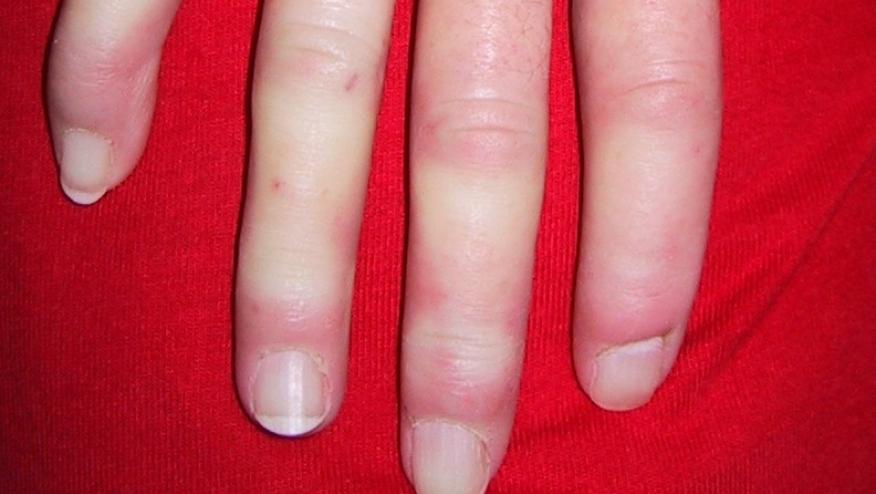Novel Biologic Promising in Mid-Stage Scleroderma Trial Save

The anti-interleukin agent romilkimab showed significant benefits on skin fibrosis among patients with systemic sclerosis in a phase II trial, researchers reported.
At week 24, the least squares mean change from baseline on the modified Rodnan skin score was -4.76 for patients randomized to romilkimab compared with -2.45 for those given placebo, for a mean difference of -2.31 (-4.32 to -0.31, P=0.0291), according to Yannick Allanore, MD, PhD, of the Cochin Rheumatology Institute in Paris, and colleagues.
The actual mean skin scores at week 24 were 15.43 versus 18.25 for the romilkimab and placebo groups, respectively, the investigators reported online in Annals of the Rheumatic Diseases.
"This was a really interesting study looking at a novel strategy for patients with early diffuse systemic sclerosis, which is a real challenge in terms of identifying effective therapies," commented Robert Spiera, MD, director of the Scleroderma, Vasculitis, and Myositis Center at the Hospital for Special Surgery in New York City, who was not involved with the study.
"This has been a frustrating decade, with trials of drugs that initially appeared promising but ultimately were not demonstrated as being effective treatments for scleroderma," he told MedPage Today.
Treatment options remain inadequate for systemic sclerosis, and the mortality rate at 10 years approaches 20%.
Recent studies have suggested that the immune dysregulation seen in systemic sclerosis involves a T-helper type-2 response with prominent involvement of IL-4 and IL-13, which are bound and neutralized by romilkimab.
"Those are cytokines that are felt to be important in the cellular immune response, which is very relevant to scleroderma pathophysiology," Spiera said.
To explore the possibility that this might represent a novel approach to treatment for early diffuse cutaneous systemic sclerosis, Allanore and colleagues enrolled 97 patients from 51 centers in 13 countries; mean age was 50 and mean disease duration was 21 months. The majority of participants were white women, and baseline modified Rodnan skin score was 20.6.
Background immunosuppressive therapies were permitted, including:
- Cyclophosphamide, 1 mg/kg orally per day or 750 mg or less intravenously monthly
- Azathioprine, 100 mg or less per day
- Methotrexate, 15 mg per week or less
- Mycophenolate mofetil (Cellcept), 2 g per day or less with or without low-dose prednisone
"This was a trial design that is very impressive to me in the sense that they did what we do in the real world, which was to allow background therapy," Spiera said. "Here they were adding the experimental treatment to standard of care therapy, meaning that all patients were able to receive such therapies, which could in theory make it harder to demonstrate that the study medication was having a beneficial effect."
The primary efficacy endpoint was the change from baseline at week 24 in the modified Rodnan skin score. In both romilkimab and placebo groups there was an initial improvement on this score at week 12, but it worsened thereafter in the placebo group -- "which may reflect the initial impact of background therapy," the investigators noted.
Another study known as FaSScinate evaluated tocilizumab for systemic sclerosis, finding a numerically greater but not statistically significant improvement at 24 weeks with the active treatment without background therapy.
The current study's design permitting the use of background therapy found greater improvements in modified Rodnan skin scores among patients on background immunosuppressives compared with those not on background therapy (-5.81 vs -3.64).
The study also had several secondary endpoints, and while these favored romilkimab, the differences versus placebo did not reach statistical significance, the researchers reported.
For forced vital capacity at week 24, the changes in the romilkimab and placebo groups were -10 mL and -80 mL, for a mean difference of 70 mL (95% CI -40 to 190, P=0.10). For the diffusing lung capacity for carbon monoxide, the changes were -0.12 and -0.27, for a difference of 0.15 (95% CI -0.12 to 0.42, P=0.14).
The Health Assessment Questionnaire-Disability Index showed slight improvements in both groups, with changes of -0.09 for romilkimab and -0.12 for placebo, with a mean difference of 0.03 (95% CI -0.19 to 0.24, P=0.40).
Subgroup analyses found that patients with more severe skin involvement (baseline Rodnan skin scores of 15 or higher) had significantly greater response, with a mean difference of -3.42 (95% CI -6.21 to -0.64, P=0.0083) between the romilkimab and placebo groups.
Adverse events were observed frequently in both groups, with the most common being skin ulcers, seen in 17% of the romilkimab group and 31% of the placebo group, nasopharyngitis in 13% and 12%, respectively, and diarrhea in 15% and 8%. Most of these toxicities were considered mild or moderate, the researchers said.
One patient in each group died: one of scleroderma renal crisis in the romilkimab group and one of cardiomyopathy in the placebo group. Neither was considered to be related to treatment.
The study was limited by its brief duration, the researchers said. Nonetheless, "the impact on skin met the prespecified endpoint, which is the first time that this has been achieved in a phase II study in diffuse cutaneous systemic sclerosis," the team concluded.
"It definitely showed signals of efficacy and was acceptable in terms of safety. This would warrant a further look in a large phase III clinical trial," Spiera said.
The study was funded by Sanofi.
Source Reference: Allanore Y, et al "A randomized, double-blind, placebo-controlled, 24-week, phase II, proof-of-concept study of romilkimab (SAR156597) in early diffuse cutaneous systemic sclerosis" Ann Rheum Dis 2020; DOI: 10.1136/annrheumdis-2020-218447.








If you are a health practitioner, you may Login/Register to comment.
Due to the nature of these comment forums, only health practitioners are allowed to comment at this time.